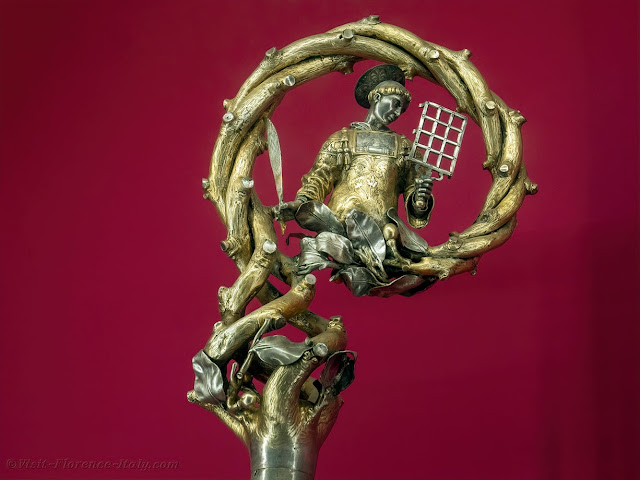As the account goes, after his mentor, Pope Sixtus II, was captured in the catacomb of Callixtus and martyred, Lawrence was brought before the Roman authorities and ordered in his capacity as archdeacon to bring forward the treasures of the Church. St. Lawrence asked for three days to collect them and then spent three days distributing those treasures to the poor in the form of alms. He then returned to the prefect after the allotted three days and brought before the Roman prefect the people themselves, presenting them as the "treasures of the church" that had been demanded. The Roman prefect was so angered by this that St. Lawrence was ordered to be put to death, being affixed to a gridiron that was then placed over burning coals. It was in the context that St. Lawrence's made his famous quip to his torturers: "Turn me over for I am done on this side." Between this quip and Lawrence's turn of play about the treasures of the church, is it any wonder he is the patron saint of comedians? He certainly demonstrated a great capacity for wit and humour.
 |
| An antique medal depicting St. Lawrence's martyrdom on the grill |
 |
| A depiction of St. Lawrence on a crozier |
As noted, Christian Rome has long shown a great interest in and devotion to St. Lawrence. In fact, two of the ancient tituli were named after him: San Lorenzo in Damaso and San Lorenzo in Lucina.
 |
| The relic of a piece of the gridiron St. Lawrence was martyred upon found in San Lorenzo in Lucina |
 |
| Interior of San Lorenzo in Damaso |
Other churches in Rome dedicated to the saint include San Lorenzo in Fonte (where the saint is said to have been imprisoned), San Lorenzo in Panisperna (where he was executed on the gridiron), San Lorenzo in Piscibus and, located just outside the Lateran basilica, the chapel of San Lorenzo in Palatio ad Sancta Sanctorum.
 |
| Facade of San Lorenzo in Fonte |
 |
| Detail of the high altar and sanctuary fresco (depicting the martyrdom of St. Lawrence) at San Lorezno in Panisperna, founded on the site where his martyrdom was said to have happened. |
 |
| Interior of San Lorenzo in Piscibus as it looked prior the 1950's when all of its baroque accoutrements were stripped. (What it looks like today.) |
However, in addition to all of these we cannot neglect one of the most important churches dedicated to St. Lawrence in Rome: San Lorenzo fuori le Mura (St. Lawrence Outside the Walls) -- formerly classed as one of the five "patriarchal basilicas" which have been now been renamed as "papal basilicas." It is one of the most important churches in Rome and one of the traditional seven pilgrim churches.
 |
| Facade of San Lorezno fuori le Mura |
At one time this facade had decoration on it, similar to that of San Paolo fuori le Mura, which unfortunately was lost during the Second World War when the basilica was damaged due to bombing.
 |
| A look at the altar and sanctuary of San Lorenzo fuori le Mura as photographed in the 19th century |
 |
| Two other views of San Lorenzo fuori le Mura |
Located on the triumphal arch that separates the nave from the sanctuary, facing toward the altar, is a mosaic which includes an image of St. Lawrence and alongside him is Pope Pelagius II who is the builder of the basilica.
Aside from all of the structures that can be found in Rome alone dedicated to St. Lawrence (to say nothing of countless depictions of the saint), Roman devotion to him can be seen readily enough by virtue of the fact he is one of the few saints whose name is embedded into the Roman Canon.
The Roman-Christian poet, Prudentius, also testifies to this devotion by way of his fourth century "Hymn in Honour of the Passion of the Blessed Martyr Lawrence" in which he testifies to the Roman devotion to the saint:
The Roman people, who were wont
The cup of Numa to adore
Christ’s sanctuaries now frequent
And hymn the holy martyr’s praise.



















